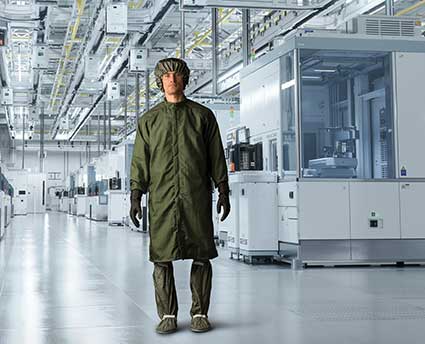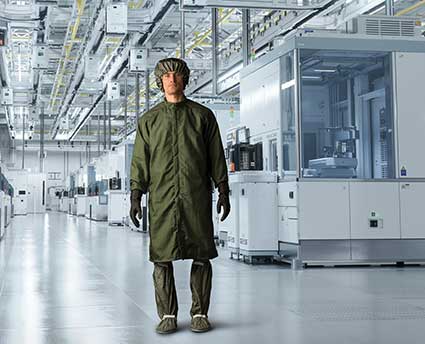In cleanroom environments, the significance of proper gowning can’t be overstated. These specialized garments serve as the first line of defense, shielding products from contamination in sensitive settings such as pharmaceuticals, microelectronics and medical device facilities.
The Role of Cleanroom Gowns
Cleanroom gowning serves a two-fold purpose, safeguarding:
- The Product: Preventing external pollutants from compromising the integrity of sensitive products and processes.
- The Environment: Maintaining the sterility and purity of the controlled area, which is crucial for compliance with stringent industry standards.
Different industries mandate varying levels of cleanliness, resulting in a range of cleanroom gowns tailored to meet these specific needs. The cleanroom fabric these gowns are crafted from is a critical factor distinguishing these gowns.
Exploring Cleanroom Fabric Categories
Woven Fabrics
Among the most prevalent materials, woven fabrics are crafted from continuous filament yarns of polyester. The thickness of these filaments and yarns determines their ability to filter particles, making them a staple in numerous cleanroom settings.
Laminated or Membrane Fabrics
Sometimes used in high-grade microelectronic environments, these fabrics aren’t commonly used in pharmaceutical sectors due to their characteristics, such as a lack of breathability and particle generation.
Disposable or Limited Life Materials
Crafted from spun-bonded olefin and polypropylene, these non-woven fabrics offer effective protection for a restricted duration. However, they require processing and decontamination before use, commonly applied in hazardous product settings.
Features Essential in Cleanroom Fabric Garments
Cleanroom garments must possess several key characteristics to ensure optimal performance:
- Low Particulate Shedding: Preventing the release of contaminants into the environment.
- Breathability and Particle Entrapment: Allowing air circulation while trapping particles within the garment.
- Flexibility and Comfort: Ensuring ease of movement for wearers.
- Durability and Endurance: Withstanding cleaning and sterilization cycles without compromising integrity.
- Meeting Specific Requirements: Addressing industry-specific needs like static control or opacity.
- Aesthetic Appeal and Cost-Effectiveness: Balancing functionality with visual appeal and economic viability.
Gown Lifespan and Maintenance
Duration of Wear
Factors like perspiration, temperature, humidity and cleanroom grades influence the amount of time these gowns may be worn.
Factors Affecting Lifespan
Cleanroom class-based policies and repair capabilities significantly impact gown lifespan.
Laundering and Sterilization
Proper washing protocols and suitable detergents are crucial, as sterilization processes can affect gown integrity.
Contamination Risk Assessment
Various methods such as particle counting (like the Helmke Drum test1) and alternative evaluations (like the Body Box test2) assess contamination risks associated with gown usage.
Vestis: Your Cleanroom Gowning Partner
Cleanroom gowning, especially the fabric selected, plays a pivotal role in maintaining sterile and non-sterile environments. By understanding the significance of different cleanroom fabric, their features and proper gown maintenance, industries can provide better standards of safety, product integrity and environmental cleanliness within controlled environments.
Reach out to Vestis to explore how our cleanroom gowning and cleaning supply rentals can help enhance your controlled environment’s safety and compliance measures.
1, 2 “People in Cleanrooms: Understanding and Monitoring the Personnel Factor” by Tim Sandle, PhD, Dec. 16, 2014.
(https://www.researchgate.net/publication/299507535_People_in_Cleanrooms_Understanding_and_Monitoring_the_Personnel_Factor)



